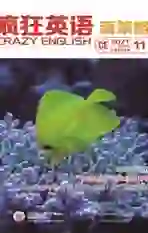珊瑚的培养
2021-01-06闫思思
闫思思
珊瑚是地球上最古老的海洋生物之一,由于環境污染,全球珊瑚种类及数量急剧减少。本文介绍了珊瑚培养的最新研究,从研究内容、研究过程和研究意义等方面对珊瑚的培养进行了说明。
Studying corals usually requires either observing them alive in the ocean or examining their dead tissue in a laboratory. But new research offers a way to keep all coral cell types alive in a lab culture for two weeks or longer, opening novel experimental possibilities.
The cells of cnidarians(刺胞动物) are difficult to culture. These cells are easily damaged during extraction(提取), and corals also have complex microbiomes that are tricky to wipe out with antibiotics—but if left alive, the microbes often take over cell cultures.
Many cnidarians are both endangered and critical for marine ecosystem health. “We need to do more than just document their death,” said University of Miami marine biologist Nikki TraylorKnowles, who is the senior author of a new study in Scientific Reports. In it, her team details how to reduce a coral to its constituent cells and then grow them all together—like cultivating the animal on a plate.
The researchers made slight changes to a standard growth medium (made of seawater, chemicals and antibiotics) to reach ideal formulas(公式) for two different cnidarian species. These formulas let all the tested species cell types grow at once, without irrelevant microbes. The new methodology will bring unparalleled visibility into how cell types interact, TraylorKnowles said, and it will allow for highervolume experiments without raising or killing whole animals.
Scientists do not yet understand all cnidarian cell types, let alone their functions. These cultures could show how different cells respond to stressors, which types are most vulnerable to health failures—and possibly where cnidarians get their impressive regenerative abilities.
The study is groundbreaking, said molecular biologist Juris Grasis of the University of California, Merced, who was not involved with the paper but also studies cnidarians. He said he was“jealous as hell” when he saw the result. Some cell populations survived for as long as 30 days, he noted—which bodes well for the possibility of scaling up cell reproduction for future research. Next up, Grasis said, “How do we translate this back into the field and make corals healthy again?”
1. What is the new research on studying corals?
A. Scientists can study corals by examining their dead tissue in a lab.
B. Scientists can study corals by observing them alive in the ocean.
C. Scientists can study corals by adopting new scientific methods.
D. Scientists can study corals by keeping them alive in a lab.
2. Why is it important to culture corals?
A. Because corals are easily damaged.
B. Because it is important to reduce a coral to cells.
C. Because corals are important to the ecosystem underwater.
D. Because the microbiomes of corals are difficult to remove.
3. How did the researchers cultivate corals?
A. By perfecting culturing formulas. B. By interacting with cells of the corals.
C. By clearing the seawater. D. By culturing antibiotics.
4. What can be inferred from Juris Grasis?
A. He felt jealous of the progress.
B. He thought the study was a great breakthrough.
C. He thought it difficult to go on the future research.
D. He had a better understanding of the functions of the study.
Themecentered chunks
novel adj. 新穎的
culture v. 培养(细胞或细菌)
tricky adj. 棘手的
take over 接管
critical adj. 关键的
document v. 记录
reduce...to 使陷入(更坏的)境地
cultivate v. 培养
allow for 考虑到;允许有
let alone 更不用说
respond to 对……作出反应
vulnerable adj. 易受伤害的
scale up 扩大
